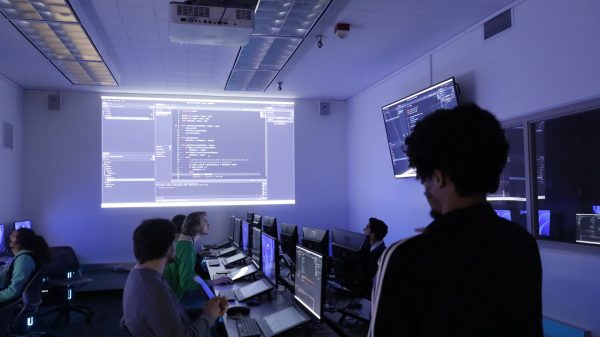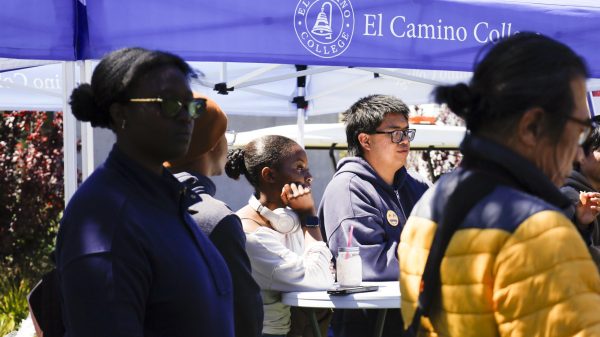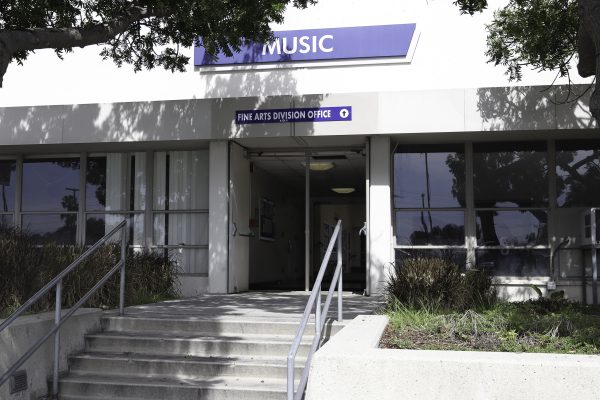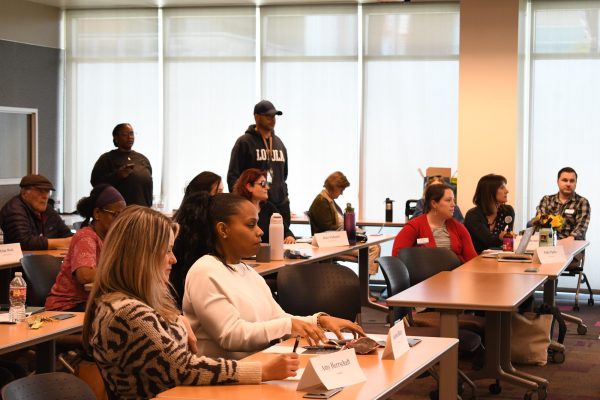Statewide trends indicate decrease in community college enrollment from diverse groups
El Camino College officials prepare to aid disproportionately affected students: Black student population identified as group most in need
As enrollment numbers among minority groups across California community colleges decrease, El Camino College has identified Black students as the college’s “annual priority” after determining that they haven’t performed as well as other groups.
The Black student population group has steadily decreased at ECC over the last five years by 8.81%, yet the same is true for the overall state numbers, dropping by 14.2% during the same time period.
The most significant drop at ECC happened during the 2019-2020 academic year, according to the California Community College Chancellor’s Office Datamart (CCCCOD).
Viviana Unda, director of institutional research and planning at ECC, told the Board of Trustees during their Oct. 15 meeting that her office identified Black students as the priority group, meaning the college should seek to aid them the most through 2022.
“[Five] of our seven lagging indicators and all of our leading indicators, incorporated Black and African American students as disproportionately impacted, so they perform not as well as we would expect,” Unda said.
The lagging indicators Unda’s office observes include factors like degree completion, transfer rates, living wage attainment and field of study. Leading indicators include course withdrawals, retention rates and employable skill attainment.
“The college is looking at different kinds of data and making sure that the way in which we implement our actions, and the way in which we are allocating our budget, really directly impacts students,” Unda said.
Jeremy Smotherman, career technical education (CTE) research analyst at ECC said the data used to identify these issues are gathered from a myriad of sources like the California Community Colleges application (CCCApply), the Labor Market and the CTE Employment Outcomes Survey (CTEOS).
“[It] provides us, again, a more detailed component of really what the student journey is like, and we utilize that information to tell us where our success is at [and] where do we need to have improvements upon,” Smotherman said.
He also said race and ethnicity are only one component of diversity, but they help to show how “students are really progressing” at ECC.
While Unda’s office analyzes student data in order to identify areas of improvement at ECC, whichever steps are carried out to make those improvements fall on the other offices at the college and its student services.
“We [ECC] have divisions, departments, programs, that will take this information and build it into what their plan is for the year or maybe for the next four years,” Smotherman said. “We are more [laying] the data foundation.”
Robin Dreizler, dean of enrollment services at ECC, said his biggest concern in regard to underrepresented students, like the Black and American Indian/ Alaskan Native groups, lies in how they might be put at a further disadvantage due to COVID-19.
“My concern in this COVID environment is a lot of these [vulnerable] populations have lost their support,” Dreizler said. “And it’s particularly concerning because they’re not at their high schools, they’re not walking by their counseling offices, they’re not walking by their college and career centers and so I think they’re missing out on a bit of a push.”
He believes ECC will have to do more for incoming students who now have limited access to counselors and college resources, by being more direct with their outreach and marketing.
“They may be the first-gen students, [and] they’re supposed to get onto our website and figure out the maze that is the process and find the support that’s specific to them?” He said.
Lack of student access to technology, college and financial aid application help, even programs made to help them, all worry Dreizler.
“We’ve had these discussions in Enrollment Management [and] in Enrollment Services,” he said. “And we’re hoping that we can fill some of these gaps that are being left by the high schools basically being closed.”
Seniors from North Torrance High School, one of El Camino’s feeder high schools, have felt unmotivated in applying to college due to family and financial circumstances that arose from the COVID-19 pandemic.
To counteract this, Karen McKelvey, the college and career counseling coordinator at North High, along with other counselors have hosted Zoom workshops and created a website with step-by-step instructions, information, videos and links to promote seniors to apply to college.
But even with the resources that the counselors have been providing, McKelvey noticed that the engagement levels have still been low, she said.
“Only the real self-motivated students are [engaging], but the majority of them are not and that’s what’s making it so so hard, you know?” McKelvey said.
Three Zoom EC preparation workshops were held in October that focused on financial aid, general information and application preparation. Only about 15-to-20 of the 475 seniors at North High attended each of the workshops, McKelvey said.
“It’s really sad,” McKelvey said. “All four [TUSD] high schools did [workshops] as a group. There was a CSU workshop, and there was a UC workshop and there was an El Camino workshop. The highest attended one was 60 kids.”
In previous years, about 45% of North High’s seniors went on to a two-year college straight after high school, with 98% of them going to El Camino, McKelvey said.
While the current resource engagement levels have shown low numbers, McKelvey said that it’s too soon to determine the number of seniors who applied to El Camino due to the college not having an application deadline.
Because of difficult circumstances that students may be experiencing due to COVID-19, McKelvey said that she understands if some students put off going to college.
“There’s a handful of students I know that are working on [college applications],” McKelvey said. “But for the most part, you know, maybe home financial situations have changed and they don’t think college is an option.”
Despite the many factors that may be discouraging seniors from applying to college, McKelvey said that she will continue to try to engage with them and heavily promote going directly to a two-year college after graduating high school.
“I think it’s such a better thing for students, especially now,” McKelvey said.
Cerritos College prioritizes campus diversity
Over the past five years, Cerritos College saw an overall increase in the number of students of different ethnic identities enrolled, whereas the community colleges in California saw an overall decrease.
According to the California Community Colleges Chancellor’s Office Data Mart, the Black, Filipino, and white non-Hispanic ethnic groups at Cerritos College saw a large spike in student population between the 2018-2019 and 2019-2020 school years.
The Black student population went up by almost 300%, the Filipino population increased by 214.34% and both the multiracial and white non-Hispanic populations rose by about 140%, according to the Data Mart.

Yvette Tafoya, Cerritos College dean of enrollment, said diversity is one of the school’s strengths which is why students, faculty and staff strive to create a variety of services aimed towards helping and supporting their community.
“We are a Hispanic serving institution so over 60% of our student population identifies as Latinx,” Tafoya said. “I think it’s just a reflection of the communities we serve.”
Because of the ongoing coronavirus pandemic and Black Lives Matter protests surging across the country, Cerritos College created a dean of student equity position, aiming to provide its students with more support.
Cerritos College has also maintained its student ethnic diversity levels due to the community demographic and services the school provides such as programs supporting pregnant students and students with communication barriers, Jacqueline Rosales, admissions and records technician at Cerritos College said.
“We have programs that just motivate students to feel welcome and want to continue education and feel supported,” Rosales said. “We’ve opened a lot of programs, or clubs, that welcome our students with language barriers, communication barriers or disabilities.”
Despite everything that has been going on in America’s current economic and political climate, Rosales said that Cerritos College has been able to meet its students’ needs in order to support them and each of their diversities.
“I believe that a lot of people are going through really tough situations right now, but we’ve made them feel so welcome and we’ve let them know that school and education [are] important,” Rosales said.
Fullerton College, Santa Monica College and Los Angeles Pierce College observe increase in unknown population, decrease in diverse student populations over last five years
Over the last five years, Fullerton College has seen an overall decrease in student population in almost every ethnicity group. The unknown population, however, saw an 82.44% increase in population during this time.
This decrease is not shocking, as California Community Colleges as a whole have also seen a decrease in overall student population over the last five years, but have seen an 5.57% increase in the Hispanic population, a 0.73% increase in the multiracial population and a 24.88% increase in the unknown population.
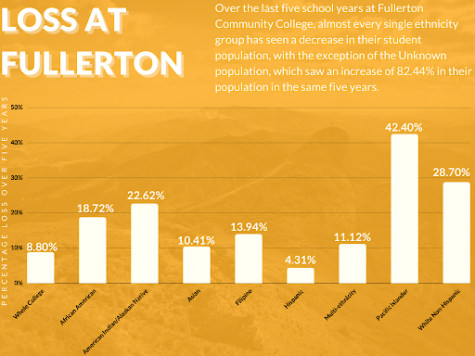
Although the college has seen an overall decrease over time, some ethnicities didn’t see a decrease every single academic year in the past five years.
Asian Americans and Hispanic Americans saw an increase in their population between the 2015-2016 and the 2016-2017 school years, with Asian Americans having a 2.44% increase, and Hispanic Americans having a 2.71% increase.
This increase would disappear completely during the 2017-2018 school year for Asian Americans, and during the 2018-2019 school year for Hispanic Americans.
The largest decrease in population is from the white non-Hispanic population. During the 2015-2016 school year, this population had 7,196 students enrolled at Fullerton, but by the 2019-2020 school year, this population would go down by over 2,000 students, having 5,131 students enrolled.
Sociology professor and faculty student advisor for sociology, A. James McKeever said there are outside reasons as to why certain student populations are not attending California community colleges.
Over the last couple of years, there has been an exodus, of specifically African American students, going back to where their families were originally from such as southern states, as Southern California might be too expensive to live, McKeever said.
The population percentage decrease from the data is not just because less of a race is going to a community college, but also because there are less people from that specific population, McKeever said.
“Even with the white population, [it’s] not that there is less of them going back to school, but every year there is less and less white people in comparison to people of color,” McKeever said. “It doesn’t surprise me at all that [the] Latino population is growing because the Latino population across the country is growing.”
Subjectivity in filling out information when applying for colleges could also be the cause of certain populations, like the multiracial population, to grow, as more people could be filling out that they are multiracial rather than a specific ethnicity.
For the unknown category, some students such as Latino and Middle Eastern students may feel like they don’t fit in with the populations listed, so they choose unknown, McKeever said.
In order to bring in students from a wider range of demographics to cater to students more effectively, McKeever said Los Angeles Mission College has made it’s community, which is largely Latino based, it’s main focus.
“That’s made an improvement where they have been able to increase the number of students ever so slightly or stay relatively the same, in comparison to a campus like Pierce that was a predominantly white campus for a long period time, is now predominantly a Latino campus and has not adjusted to demographic shift, and we need to do things to make the campus feel safe and friendly for this new demographic,” McKeever said.
McKeever said he recommends that campuses have programs that cater to certain groups and ethnicities and brings up the Hispanic population as an example. In doing so, it makes the curriculum less predominantly white-focused.
“You need to increase the diversity of your faculty too because that will bring students there and make them feel comfortable and give them a mentor that they can go to and are comfortable with,” McKeever said.
Before hiring someone for Chicano Studies at Pierce, McKeever was the advisor for a Mexican American group called MEChA, but wasn’t Latino himself.
“[It] demonstrates the connections, particularly with oppressed groups, where oppressed groups can now see that ‘wow, this person is talking about oppression in the same way my people experience it,’ and then you can kind of make the connections to find allies and work on social justice from more of a intersectional perspective.”
Marketing to the community also plays a role in getting students to join colleges. Students that are going to college because they think they want to or that their parents are making them go to college are one excuse away from never coming back. If the website isn’t easy to navigate or no one from the college answers the phone, they lose that student, McKeever said.
Economy also plays a role in students attending college, as recessions and job loss usually prompt more individuals to join a community college, but they also indicate that more people are struggling financially.
Sometimes when people are struggling and are able to find a job with decent hours, it is nice to put some money in their pocket, but when there are layoffs and people can’t find work, that is usually when they go back to college, particularly community college, McKeever said.
When jobs are more available however, college administration goes down.
“It is harder to go to school when you are working then when you are not, so that’s a big part of the issue too, and if their parents aren’t doing as good as they used to in the past, their parents might be insisting on them finding jobs, helping support themselves,” McKeever said. “If they end up having to pay for college on top of that and pay for their room and board, sometimes you are going to miss a few payments and maybe you can’t take out any more loans.”
This long-term financial burden may dissuade students from continuing their schooling, focusing on their job instead.
“It’s scary for people who are working class to take out loans because they just see it as debt, they don’t see it as an investment in their future because it may not be an investment in their future, it might end up being debt, there is no guarantee you’re going to get a great job in the end, so that’s a big worry for people,” McKeever said.
Los Angeles Pierce College (LAPC) has also seen a decrease in enrollment, and an increase in their unknown ethnicity population.
Among the largest decreases at LAPC are Black student enrollment, which has decreased by 22%, American Indian and Alaskan Native student enrollment which has decreased by 46% and Asian student enrollment which has decreased by 26%, according to the Data Mart.
In contrast, students with unknown ethnicities’ have increased enrollment by 53% at LAPC, according to the Data Mart.

Human capital management professor at Columbia University, Edna Chun said diverse colleges have a positive impact on the students with their learning outcomes, global learning and their engagement with others.
“It [diversity in colleges] has been studied extensively and determined that it is a vital part of student learning and preparing the students to work in a global world,” Chun said.
According to CCCCO in the 2017-2019 academic year for LAPC, Filipino student’s enrollment rate dropped drastically.
Dean of institutional effectiveness at LAPC, Amari Williams said the huge decrease was a technical mistake because during the 2017-2018 academic year they switched to a different site. which caused Filipino students to be coded into different groups.
LAPC is doing an ongoing project that collects data from students regarding issues of race and diversity that may or may not be impacting their college experiences, Williams said.
“I see on my campus now, is more opportunity and more space being given to discuss issues of race,” Williams said. “Discussion of how different communities on our campus may experience the day to day of being a student, or staff member or faculty member appears differently, largely, because maybe they are one race and not the other.”
Chun said, diverse colleges can have an impact on students’ perspectives regarding others, cross-racial friendships can help eliminate racism.
“Cognitive dissonance challenges the way you have been thinking about things challenges your view,” Chun said. “Cognitive dissonance takes place when you meet someone different than yourself makes you rethink what you felt.”
Former El Camino College student Adrian Rodriguez, computer science major said if the school is not diverse enough then the minorities will feel unmotivated and left out.
“If I went to a school where there weren’t many Hispanics, as a Costa Rican and Nicaraguan crossbreed, I would definitely feel left out,” Rodriguez said. “I feel that having a diverse school environment allows minority students to feel more accepted, welcomed and at home.”
As observed across the state, Santa Monica College (SMC) has also seen a steady increase in the unknown ethnicity population, which in recent years has been linked to a change in the international student enrollment application.
Dean of institutional research at Santa Monica College Hannah Lawler, said that international students reporting their ethnicities on the application form have also contributed to the increase in the unknown ethinicity reported population.
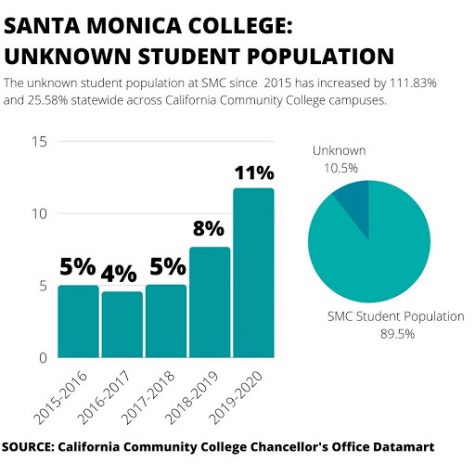
“For many of our students that come from countries that are [aware of where they are from, however] indigenous, race and ethnicity is just not a thing that they really understand,” Lawler said. “And you know, a lot of them are non-native English speakers and so they typically don’t know how to answer that question so they leave it blank.”
According to the California Community College Chancellor’s Office Data Mart, the unknown student population has seen the highest increase at SMC within the past five years — 111.83%.
According to an article from World Education News & Reviews (WENR), an information and news source in international education, international students are “often viewed through the prism of American racial and ethnic classifications” which puts them in a separate ethnic group altogether.
“It’s highly correlated, the unknown, with our international student population,” she said. “They actually complete a different college application which is where we collect our ethnicity and race information,” Lawler said.
International Student Program: How they have been impacted by the pandemic
While the pandemic has put a halt on new F-1 student visa applications, El Camino College has allowed international students to continue their education despite COVID-19.
Lindsey Ludwig, director of the International Student Program, said with the uncertainty of oversea travel, and changing regulations in F-1 student visa status, ECC has become a second home for international students.
“Our student population returned to our school because we’re their community, and we’re their family,” Ludwig said.
Since March, the collaborative efforts from El Camino’s library and their services such as Live Chat have been a critical platform for international students to stay connected with ISP at any time, Ludwig said.
“So [Live Chat’s] been really helpful because [F-1 visa students] have a person that they can talk to a live staff member, pretty much any time during the day, and then we have it [available] into the night hours as well,” she said.
Additionally, Ludwig said that ISP’s current online format continues to engage the student community with weekly town hall meetings, game nights and conversation nights held monthly, in addition to ensuring that current F-1 visa students meet their core 12 unit requirement.
While new F-1 student visa applications aren’t currently being accepted, Ludwig said current and new students have full access temporarily to distance education during the pandemic despite some not being an official visa applicant.
“Right now, there’s been some flexibility with immigration and within El Camino, that we are allowing non residents to begin their studies from their home or to continue their studies from their home country, just so that they can [continue their education] … until COVID and the embassies open [back up],” Ludwig said.
The students of ISP have been able to continue forward with their education amid the pandemic despite being countries away from ECC, Ludwig said.
“I really love our international student community,” she said. “And I think that they, they’ve done a tremendous job, still attending classes um, far from home, or in their home country.”
This story was contributed to by: Nicholas Broadhead, Zoha Jan, Rachel Maldonado, Madison Phan and Jeniffer Torres.
EDITOR’S NOTE: THIS STORY WAS UPDATED ON DEC. 7 TO CORRECT A TITLE.


